Table of Contents
In 2025, the integration of AI in physiotherapy is no longer a futuristic concept—it’s becoming the new standard in rehabilitation care. From smart wearables that track your every movement to virtual reality rehabilitation programs that immerse patients in gamified recovery, modern physiotherapy is experiencing a digital revolution.
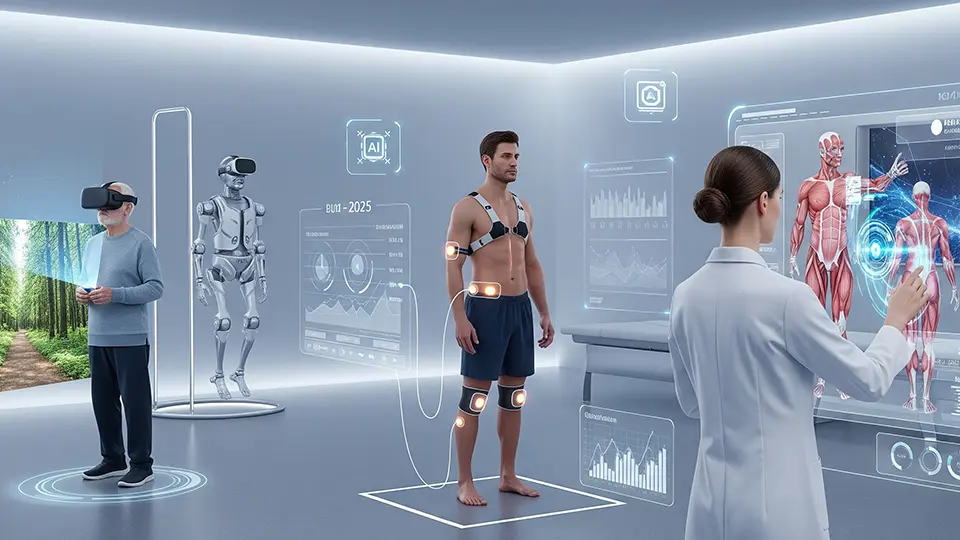
These technologies are not only enhancing how physical therapists diagnose and treat injuries, but also empowering patients to recover faster, safer, and more effectively—whether at home or in a clinic.
- Imagine AI-powered motion sensors that detect improper posture before it leads to injury.
- Or VR-based therapy that keeps stroke patients engaged through interactive neuro-rehab games.
- Or even wearable rehab tech that sends real-time data to your physiotherapist—so treatment adapts automatically based on how you’re moving.
Whether you’re a healthcare professional, a recovering athlete, a senior managing chronic pain, or a physiotherapy clinic owner exploring the latest tech — this is the moment to understand how artificial intelligence, virtual reality, and wearable devices are reshaping the entire field of physical rehabilitation.
In this post, we’ll explore how each of these cutting-edge technologies is being used in real physiotherapy settings, the benefits they bring to patients and professionals, and where the future is headed.
🤖 Artificial Intelligence (AI) in Physiotherapy: Smarter Diagnosis & Personalized Rehab
AI in physiotherapy is driving remarkable advancements in diagnosis, progress tracking, and individualized treatment planning. AI algorithms can analyze vast datasets—from movement patterns to pain reports—to identify abnormalities or potential risks that might be missed by the human eye.
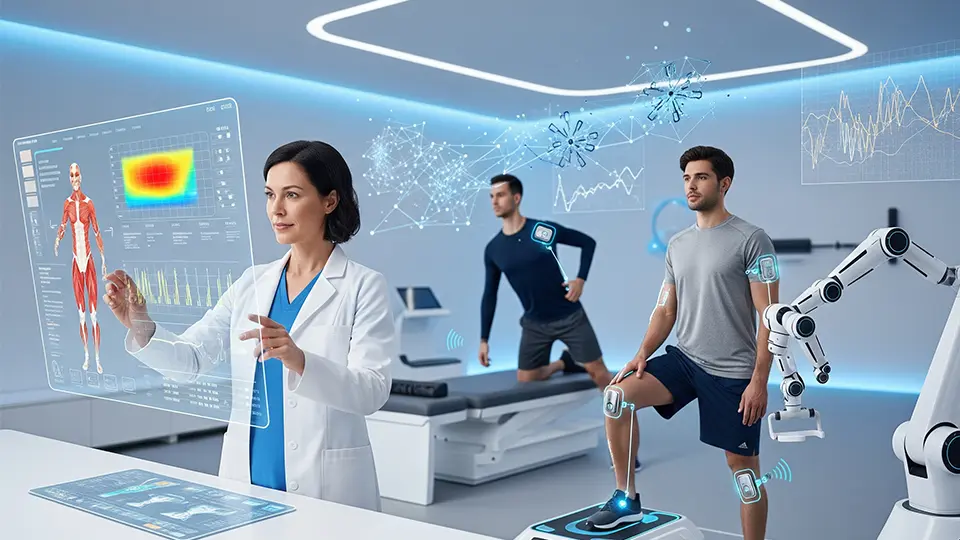
What Is AI in Physiotherapy?
Artificial Intelligence (AI) in physiotherapy refers to the use of smart algorithms, machine learning, and predictive analytics to assist therapists in diagnosing, monitoring, and treating patients more effectively. It turns subjective observations into data-driven insights, enabling therapists to deliver highly tailored care. From assessing body movement using computer vision to automating rehabilitation plans, AI is redefining what’s possible in recovery science.
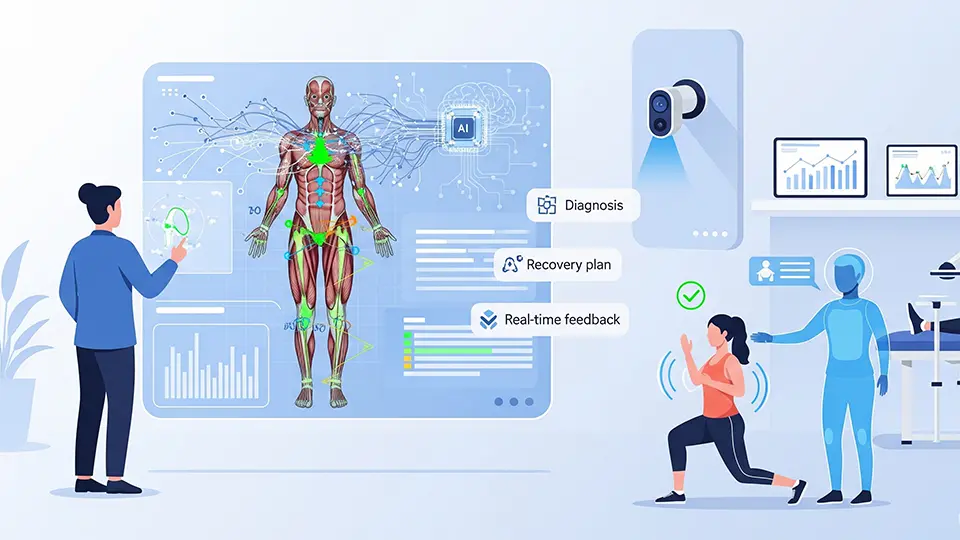
🔬 Key Applications of AI in Physiotherapy
- Computer Vision for Movement Analysis: AI-powered computer vision tools analyze body posture and joint movement with high precision. These systems use standard cameras or 3D sensors to assess a patient’s form while performing exercises. For example, Pose Estimation algorithms track joint angles in real-time, identifying any compensatory patterns or biomechanical inefficiencies that may contribute to injury.
- AI-Driven Progress Tracking: Smart rehabilitation platforms use AI to monitor patients’ performance and adapt exercises based on their improvement. These tools detect plateaus, regressions, or accelerated progress, and auto-adjust programs accordingly. This ensures the patient is always working at an optimal intensity level without risking reinjury.
- Predictive Analytics for Injury Prevention
By collecting data from previous patients, wearable sensors, or EMRs (Electronic Medical Records), AI algorithms can predict injury risks before symptoms arise. For example, if gait analysis shows a slight imbalance in stride, the system may flag it as a precursor to hip or knee strain. - Chatbots & Virtual Physiotherapy Assistants: Many physiotherapy clinics are now integrating AI chatbots in their patient engagement strategy. These bots remind patients of their home exercise routines (HEP), check in on symptoms, or even guide users through basic routines with voice or video support.
- AI in Radiology and Imaging
AI is increasingly used to interpret MRI, CT, or X-ray scans with high accuracy. This supports musculoskeletal therapists in identifying herniated discs, rotator cuff injuries, or stress fractures early, speeding up treatment initiation.
✅ Benefits of Using AI in Physiotherapy
Improved Diagnostic Accuracy
Therapists can make better-informed decisions, reducing the chance of misdiagnosis or treatment delays. AI acts as a second pair of expert eyes.
Hyper-Personalized Treatment Plans
No two patients are the same. AI allows real-time adjustment of exercise load, frequency, and type based on the individual’s actual recovery metrics.
Faster Recovery & Reduced Risk of Reinjury
By ensuring proper technique and progression, AI shortens the rehab timeline while reducing injury recurrence.
Data-Driven Documentation & Insurance Reports
AI-generated performance reports are often formatted for easy submission to insurers or compliance with medical record standards.
Enhances Therapist Efficiency
With AI taking over repetitive assessments and documentation, physiotherapists can focus on hands-on care, complex cases, and emotional support.
🧠 Real-Life Examples
- SWORD Health uses AI-guided virtual physical therapy with wearable sensors, delivering effective rehab remotely.
- Kaia Health offers an app for chronic back pain, using AI to guide and correct patient movements via smartphone cameras.
- Physiobot, an AI assistant, helps automate patient intake and evaluation before they see a therapist.
🔄 Challenges & Considerations
Despite the immense promise, AI in physiotherapy comes with some limitations:
- Data Privacy Concerns: Patient data must be encrypted and stored securely to comply with HIPAA and GDPR.
- Tech Adaptation Resistance: Older patients or small clinics may find it hard to adopt new AI tools.
- Cost & Accessibility: Not all AI solutions are affordable or available in low-income regions yet.
However, with the increasing democratization of AI platforms and user-friendly interfaces, these barriers are rapidly shrinking.
🔮 Future Outlook
Looking ahead, AI in physiotherapy is expected to integrate seamlessly with other technologies such as:
- Robotics: AI-controlled robotic arms or exoskeletons that assist in stroke and neurorehab.
- Augmented Reality (AR): Where AI assists in overlaying visual movement corrections on patients during live sessions.
- Voice-Based Diagnostics: AI may even analyze vocal cues to detect pain or fatigue levels.
As research in biomechanics and deep learning advances, AI will soon become a non-negotiable tool in every modern physiotherapy clinic.
🎮 How VR Works in Physiotherapy
VR in physiotherapy utilizes headsets and motion tracking sensors to create 3D environments where patients perform rehab tasks. These systems monitor the user’s body movements and provide instant feedback, helping guide patients through prescribed exercises in a fun, controlled, and measurable way.
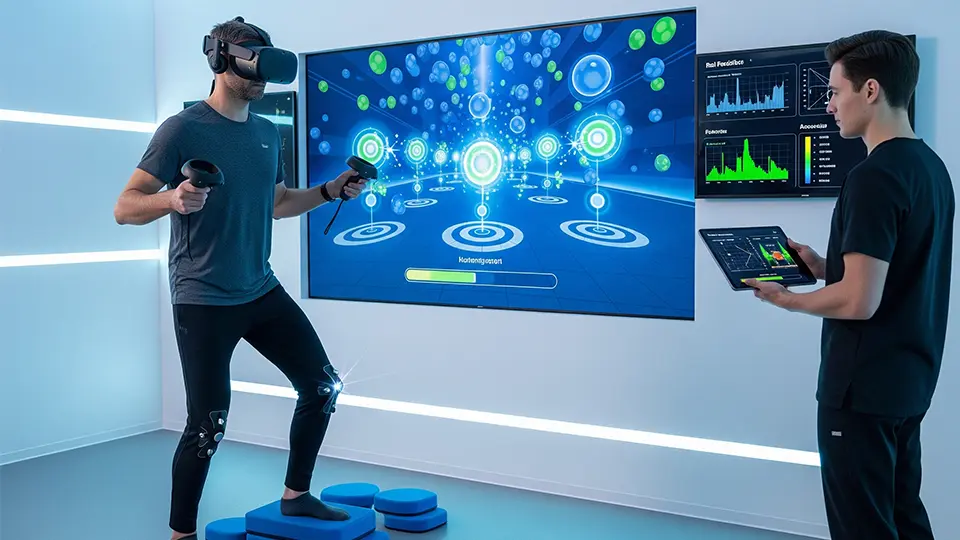
✅ Applications in Rehabilitation:
- Stroke Recovery: VR simulates environments that help retrain motor and cognitive functions, such as picking up virtual objects or navigating a space.
- Orthopedic Rehab: Patients recovering from ACL tears, joint replacements, or fractures can perform exercises that mimic real-life activities like stair climbing or walking.
- Neurological Disorders: For Parkinson’s, multiple sclerosis, or balance impairments, VR can simulate balance challenges and cognitive-motor training games.
- Pediatric Therapy: Children often struggle with repetitive rehab exercises; VR makes therapy playful and less intimidating.
📈 Evidence-Based Benefits:
Research studies and meta-analyses show VR:
- Enhances patient motivation and engagement
- Increases exercise adherence and session duration
- Improves neuromuscular control and range of motion
- Reduces fear of movement (kinesiophobia) in post-injury patients
- Facilitates dual-task training for improved balance and coordination
💡 Emerging VR Technologies:
- Room-Scale VR: Allows full-body movement tracking for walking, jumping, and reaching.
- Treadmill-Integrated VR: Simulates walking in a park or climbing stairs to enhance gait retraining.
- VR Gloves & Haptic Devices: Provide tactile feedback during hand therapy or fine motor exercises.
- Tele-VR Platforms: Combine VR sessions with remote therapist monitoring—perfect for home-based rehab.
🧠 Real-World Uses:
- Stroke Rehabilitation: Patients use VR to retrain motor control through gamified repetition.
- Balance & Gait Training: VR environments simulate challenging terrains to improve stability.
- Pain Distraction: VR experiences reduce pain perception in patients with chronic conditions.
- Mental Health Support: For patients with trauma or PTSD, VR can be a therapeutic addition to physical therapy.
📈 Clinical Benefits:
- Increases patient motivation and participation
- Enables remote, at-home rehab sessions
- Creates real-time, adjustable difficulty levels based on performance
- Collects objective movement data for analysis
“VR turns therapy into a game patients want to play—improving results across all age groups.”
⌚ Wearable Technology in Physiotherapy: Real-Time Feedback at Your Fingertips
Wearable technology has emerged as a cornerstone of modern physiotherapy, offering unprecedented real-time insights into patient movements, posture, muscle activity, and more. These compact, user-friendly devices empower both therapists and patients with data-driven precision that improves rehabilitation outcomes and patient compliance.
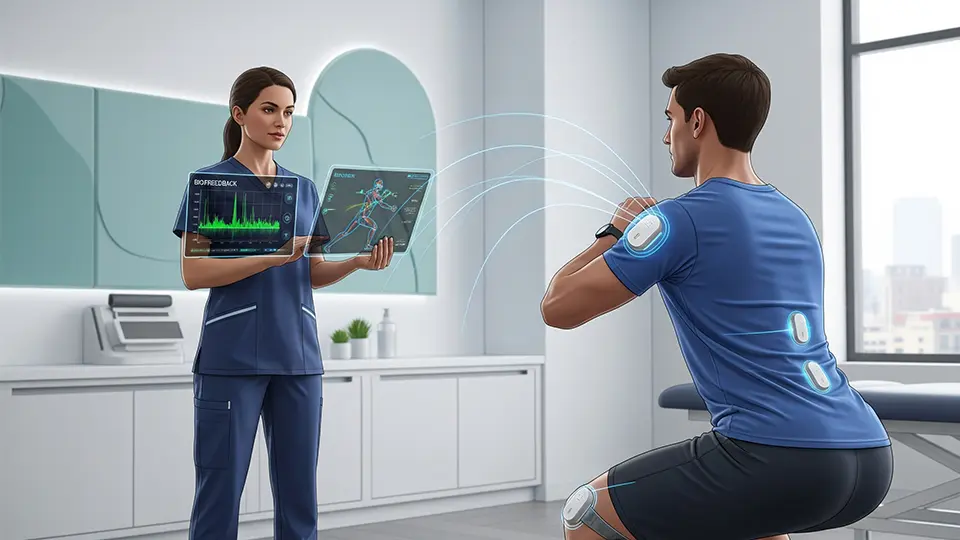
🧠 How It Works:
Wearables in physiotherapy are typically equipped with sensors such as gyroscopes, accelerometers, IMUs (Inertial Measurement Units), and EMG (Electromyography). These devices collect biomechanical data that is analyzed either through built-in algorithms or integrated with AI-based rehabilitation platforms.
- When a patient performs an exercise, the wearable monitors their motion, muscle contractions, joint angles, or balance.
- This data is instantly transmitted to a therapist’s dashboard or app, which highlights areas of concern or progress.
- Based on the real-time feedback, the therapist—or even an AI assistant—can adjust the rehabilitation protocol on the fly.
🔗 Popular Physiotherapy Wearables:
- Smart Bands & IMUs: Capture joint range of motion, velocity, and symmetry. Perfect for shoulder, knee, and post-operative rehab.
- EMG Sensors: Track muscle engagement and fatigue levels, ideal for neuromuscular re-education.
- Posture Correction Devices: Deliver vibrations or visual alerts when poor posture is detected during exercises or daily activities.
- Smart Insoles & Gait Trackers: Measure foot pressure, stride, and weight distribution—crucial for stroke, Parkinson’s, or orthopedic patients.
📊 Clinical Applications:
- Remote Monitoring: Patients recovering at home can stay connected to therapists through wearables, reducing the need for frequent clinic visits.
- Fall Prevention: Real-time balance assessments help flag high fall-risk patients.
- Rehab Gamification: Some wearables pair with mobile apps that gamify exercises and reward patient consistency.
- Insurance Compliance: Objective data logs support documentation for insurance claims and recovery verification.
🌟 Benefits for Patients & Therapists:
- Continuous data collection leads to more accurate tracking of progress
- Facilitates tele-rehab by bridging physical distance
- Encourages better patient accountability and motivation
- Supports evidence-based treatment planning
- Improves safety by detecting risky movements or fatigue early
📱 Real-Life Example:
A physiotherapy clinic treating ACL rehab patients uses smart knee bands that track flexion angles during at-home workouts. Data is synced daily to the clinic, where therapists review performance, modify programs, and send feedback to patients—all without a physical visit.
“With wearables, rehabilitation becomes a personalized, connected experience that doesn’t stop when you leave the clinic.”
As wearable tech continues to advance—with smaller form factors, better battery life, and AI-driven analytics—the line between clinic and home care is blurring, making physiotherapy more accessible and effective than ever before.
Wearables are no longer just for counting steps. In physiotherapy, wearable sensors offer real-time biofeedback, range-of-motion data, and muscle activation insights that transform how therapists monitor and adjust rehabilitation plans.
🔗 Popular Devices:
- Smart Bands & Inertial Measurement Units (IMUs): Track joint motion and detect compensatory movements.
- EMG Wearables: Monitor muscle activation and fatigue.
- Posture Correctors: Vibrate when slouching is detected, supporting ergonomic correction.
- Smart Insoles & Gait Sensors: Help refine walking patterns in neurological and orthopedic cases.
🧩 Why It Matters:
- Offers remote monitoring for tele-rehab
- Enhances patient accountability and motivation
- Provides quantifiable metrics for insurance or progress reviews
- Bridges the gap between clinic visits with ongoing feedback
“With wearables, rehab doesn’t end when the session does—it continues 24/7.”
Top AI, VR & Wearable Devices for 2025
Technology is transforming the rehab landscape faster than ever. From artificial intelligence platforms that create personalized recovery programs to wearables that detect the tiniest deviations in movement, here are the top breakthrough devices making waves in 2025:
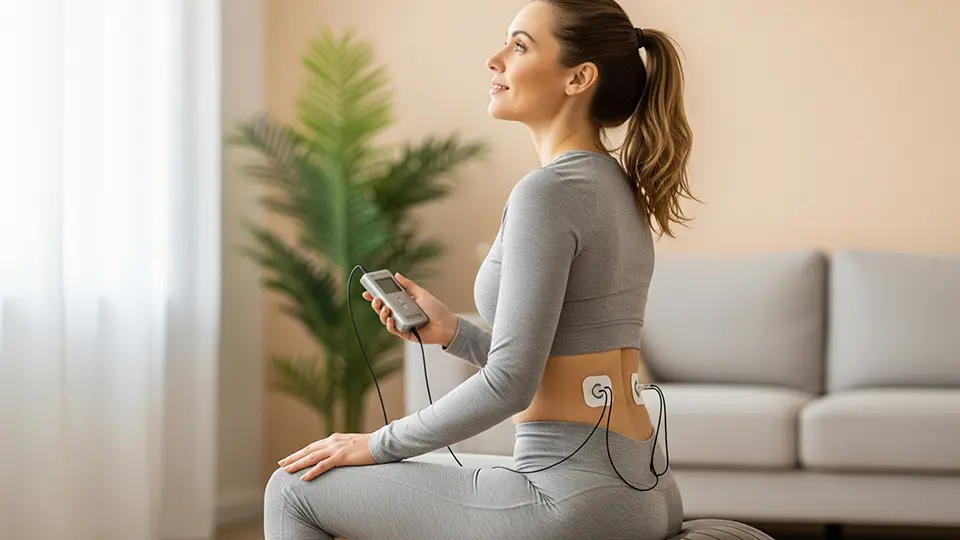
| Tool | Tech Type | Purpose |
| PhysioBot AI | Artificial Intelligence | Offers hyper-personalized home rehab programs using machine learning, adapting exercise plans in real time based on patient feedback and recovery data. Ideal for post-op patients or those managing chronic pain remotely. |
| MindMotion™ | Virtual Reality | This neurorehabilitation system immerses stroke patients and those with neurological impairments in gamified environments to improve motor recovery and engagement. Tracks performance metrics and adjusts therapy in real-time. |
| DorsaVi™ | Wearable Sensors | Provides real-time biomechanical analysis for physiotherapists. The wearable trackers are placed on the spine, knees, or shoulders to detect poor movement patterns, aid in injury prevention, and monitor rehab compliance. Great for sports rehab and postural correction. |
| Kaia Health | AI-Powered App | An app-based solution backed by clinical trials that provides AI-guided back pain relief programs. Combines movement tracking, pain education, mindfulness, and cognitive behavioral therapy (CBT) into a single digital experience. Excellent for chronic back pain and lower back pain patients. |
| NeuroVirt™ | VR + AI | This hybrid tech integrates AI-based balance correction algorithms with VR-based immersive rehab programs. Designed specifically for Parkinson’s patients, it helps train motor coordination, reduce freezing episodes, and restore balance confidence. |
🚀 New Additions to Watch:
| Tool | Tech Type | Purpose |
| RehabX™ | AI & Robotics | AI-guided robotic exoskeleton used for gait retraining in spinal cord injury and stroke patients. Uses predictive analytics to prevent falls and improve limb coordination. |
| SynPhony™ | VR + Music Therapy | Combines immersive VR environments with music-based movement therapy for neurological recovery, including TBI and stroke rehab. Boosts neuroplasticity and mood engagement. |
| Motus Hand | Wearable Robotics | A lightweight exoskeleton glove used for fine motor rehabilitation in patients with hand paralysis or stroke-related weakness. Tracks grip strength and finger range of motion. |
| Sensoria Smart Socks | Smart Wearables | These socks monitor foot pressure, gait symmetry, and weight distribution in real time. Excellent for diabetic patients, elderly fall prevention, and gait correction. |
These tools are not just gadgets—they are reshaping the very foundation of rehabilitation. By combining AI precision, VR immersion, and real-time biofeedback, physiotherapy in 2025 is more data-driven, engaging, and effective than ever before.
Clinics that integrate these tools into their practice can offer hybrid care models, improve patient compliance, and future-proof their services for the next decade of digital health.
🌍 The Global Impact: Accessibility, Remote Care & Democratizing Physiotherapy
One of the most profound benefits of integrating AI, VR, and wearable technologies in physiotherapy is the way they democratize access to quality rehabilitation care across the globe. As digital health solutions continue to evolve, they’re not just enhancing treatment outcomes—they’re also breaking down the barriers of geography, income, and availability that have long limited who can access expert physiotherapy services.
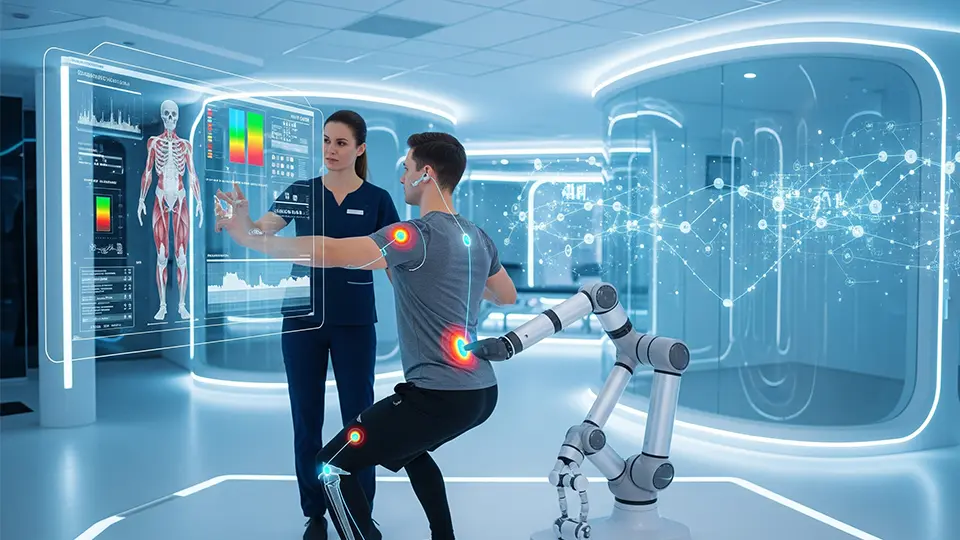
📌 From Local Clinics to Global Care
In traditional settings, patients often have to visit a physical clinic for every appointment. This becomes a major challenge in:
- Remote or rural areas where physiotherapy clinics are few and far between
- Underdeveloped countries with a shortage of trained physiotherapists
- Populations with limited mobility due to chronic pain, age, or post-surgical recovery
- Busy professionals or parents who can’t spare time for weekly appointments
Today, with the help of AI-powered telehealth platforms, wearable monitoring devices, and VR-based home rehabilitation systems, access to care is no longer restricted by distance.
For instance:
- A senior citizen in a rural village in Pakistan can now consult with a physiotherapist based in London through a virtual appointment.
- A post-op knee replacement patient in Kenya can wear a smart brace that sends movement data to a rehab team in Canada.
- A stroke survivor in Pakistan can perform VR therapy games at home while an AI engine adjusts the difficulty and tracks neuro-motor recovery.
The global reach of physiotherapy is now a reality.
📱 Remote Monitoring & Tele-Rehab: More Than a Trend
The COVID-19 pandemic accelerated the adoption of tele-rehabilitation, and that momentum hasn’t slowed. What began as a temporary solution is now becoming a permanent feature in the future of physiotherapy.
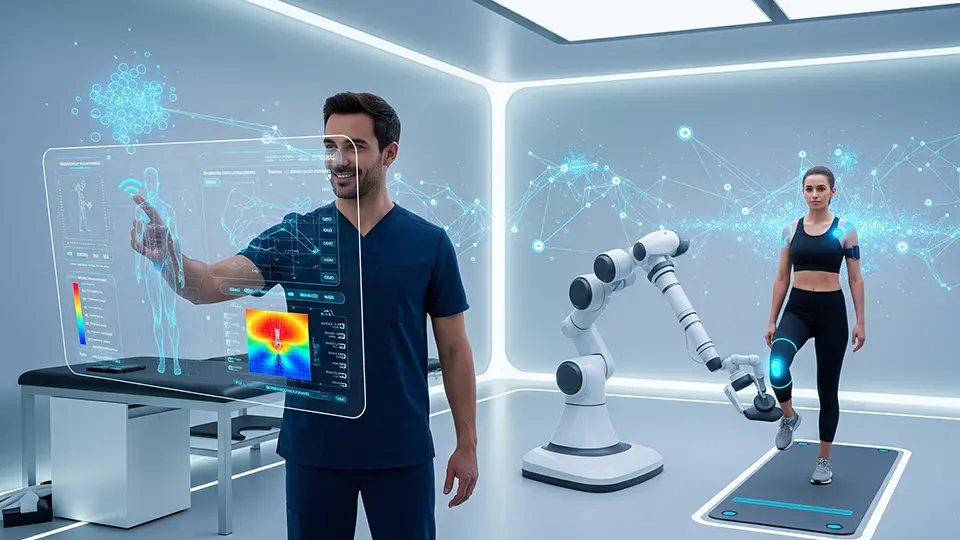
Here’s how AI, VR, and wearables make remote physiotherapy not just possible—but powerful:
- AI-enabled platforms analyze patient feedback, symptom logs, and performance data to update exercise routines in real-time.
- Wearable sensors transmit data on joint angles, muscle activation, and movement quality—allowing clinicians to assess technique without needing in-person visits.
- VR headsets create gamified rehab sessions at home, complete with progress dashboards and engagement metrics.
This level of remote feedback and interactivity ensures that patients don’t fall through the cracks just because they can’t visit a clinic physically.
💡 Increasing Adherence & Outcomes Across All Demographics
One of the major struggles in physiotherapy is patient non-compliance—either due to boredom, lack of motivation, or logistical hurdles like transportation and cost. That’s where tech comes in:
- Gamification through VR makes rehab fun and habit-forming.
- Smartphone apps with AI chatbots remind and encourage users to complete exercises.
- Wearable alerts and dashboards keep patients accountable by showing real-time feedback and goals.
Research has shown that these digital tools significantly improve adherence rates, particularly in younger patients, tech-savvy seniors, and even children undergoing pediatric physiotherapy.
🌐 Bridging Socioeconomic Gaps in Physiotherapy
Not everyone can afford private physiotherapy sessions several times a week—but everyone can benefit from structured rehab.
With wearable technology becoming more affordable, and many VR and AI platforms offering subscription-based models, access is gradually opening up even for lower-income households.
Free and open-source rehabilitation apps are also emerging, especially in global initiatives by healthcare NGOs and academic institutions. In the future, governments and insurance providers may also subsidize smart devices and virtual care platforms as standard rehab tools.
This means:
- Chronic pain patients in developing countries can receive continuous care
- Post-surgical recovery protocols can be extended beyond hospitals affordably
- Students and physiotherapists worldwide can use AI and VR for skill development and remote patient management
🌏 A Truly Borderless Future for Rehabilitation
We are witnessing a borderless evolution in physiotherapy where expert knowledge, real-time data, and personalized treatment plans can be accessed from any corner of the world. And it’s only going to grow with:
- 5G expansion, enabling smoother video and sensor data transmission
- Cloud-based rehabilitation platforms with multilingual interfaces
- Cross-border partnerships between clinics, hospitals, and technology providers
- AI translation tools to support global patient–therapist communication
“Physiotherapy is no longer just hands-on—it’s now tech-on, always-on, and globally connected.”
🔮 What’s Next? The Future of Tech in Physiotherapy
The landscape of digital physiotherapy is evolving at a rapid pace, fueled by breakthroughs in artificial intelligence, immersive tech, and connected devices.
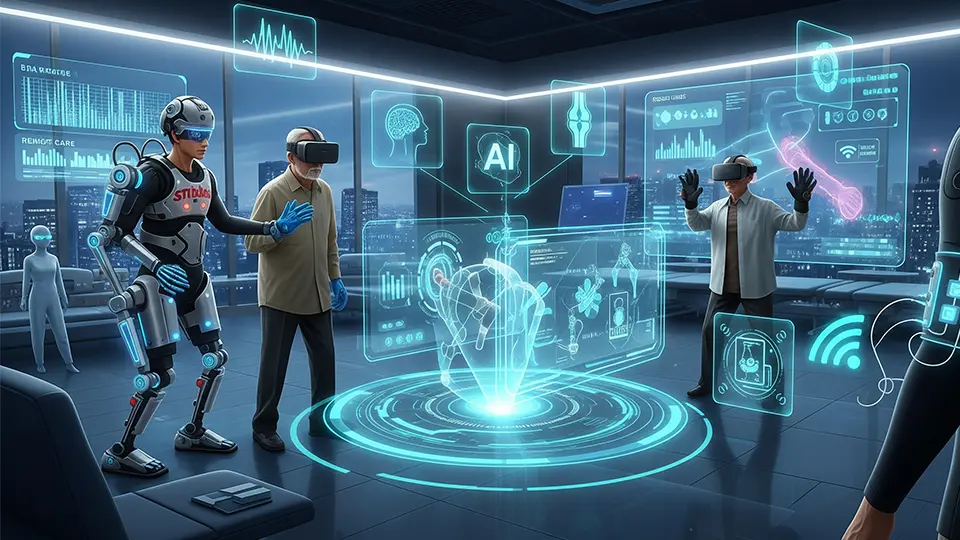
🚀 Future Trends on the Horizon
- AI + Robotics:
Expect integration with robotic exoskeletons, enabling paraplegic or stroke patients to walk again using AI-guided motion systems. - Augmented Reality (AR):
Unlike VR, AR overlays digital instructions into the real world—ideal for:- Teaching home exercises
- Assisting clinicians in remote consultations
- Enhancing physiotherapy student education
- 5G-Enabled Remote Rehab:
Super-fast 5G networks will:- Allow instant syncing of wearable data to cloud dashboards
- Enable real-time adjustments from physiotherapists
- Support multi-user VR therapy sessions
- Smart Home Physiotherapy Systems:
From AI mirrors that correct posture to voice-guided exercise coaching, the future lies in hands-free, intelligent therapy environments.
📊 Market Growth Indicators
- The global rehabilitation tech market is expected to exceed $20 billion by 2030
- Increased investment in health tech startups focused on remote care
- Greater emphasis on evidence-based physiotherapy solutions supported by AI data
“In the next five years, AI-powered physiotherapy tools will become as common as stethoscopes in clinics.”
📢 Conclusion: Embracing the Digital Rehab Revolution
AI, VR, and wearable technologies in physiotherapy are not just trends—they’re pivotal shifts in how we deliver and receive care. Whether you’re managing chronic pain, recovering from surgery, or helping others heal, these tools are enabling more accurate, engaging, and personalized rehab journeys.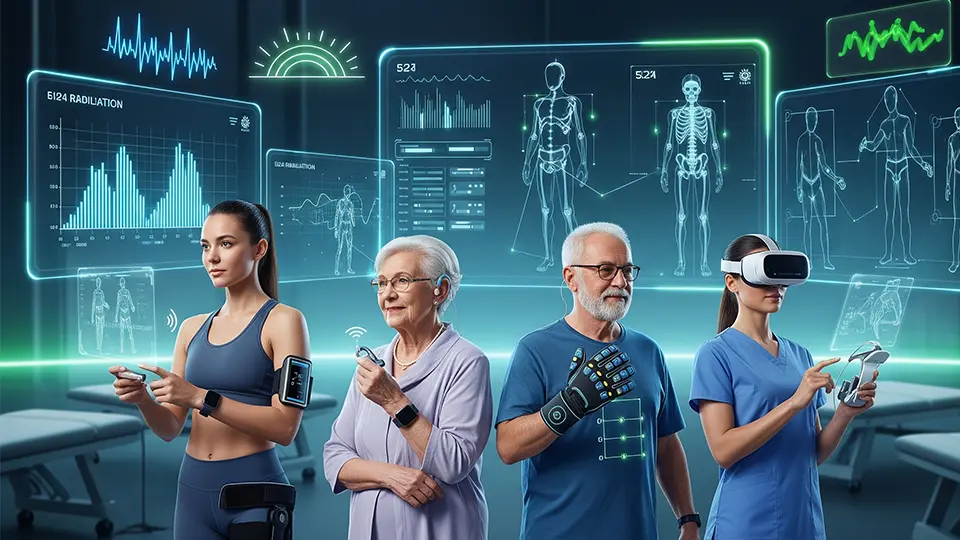
Now is the time to embrace the future—because it’s already here.
Call to Action
Want to experience the future of physiotherapy today?
✅ Book a consultation with our tech-integrated physiotherapists
📍 Visit PhysioRehabSolution.com to explore personalized, data-driven care that accelerates your recovery journey.
FAQs (Frequently Asked Questions)
Is VR physiotherapy safe for seniors?
Yes, most VR therapy platforms are designed with safety in mind. They’re especially helpful for fall prevention, balance, and cognitive training.
Do wearables replace clinic visits?
No, but they complement in-person therapy by tracking progress and providing data between sessions.
Can I use AI physiotherapy tools at home?
Yes! Apps like Kaia Health or AI-based platforms often guide patients with customized exercise routines, but it’s best to consult a physiotherapist before relying solely on them.
Are these technologies expensive?
Some can be, but many tools are becoming more affordable. Several clinics now offer VR sessions and wearable loan programs.
Is AI in physiotherapy reliable?
Yes. AI tools now match and sometimes exceed human diagnostic accuracy in gait analysis and movement dysfunctions.
Is VR physical therapy safe?
Yes. VR therapy is used widely in elderly fall prevention, stroke rehab, and pediatric physiotherapy.
How does AI personalize my physiotherapy plan?
It adapts based on real-time movement data, feedback, and performance trends, ensuring progress and minimizing re-injury risk.
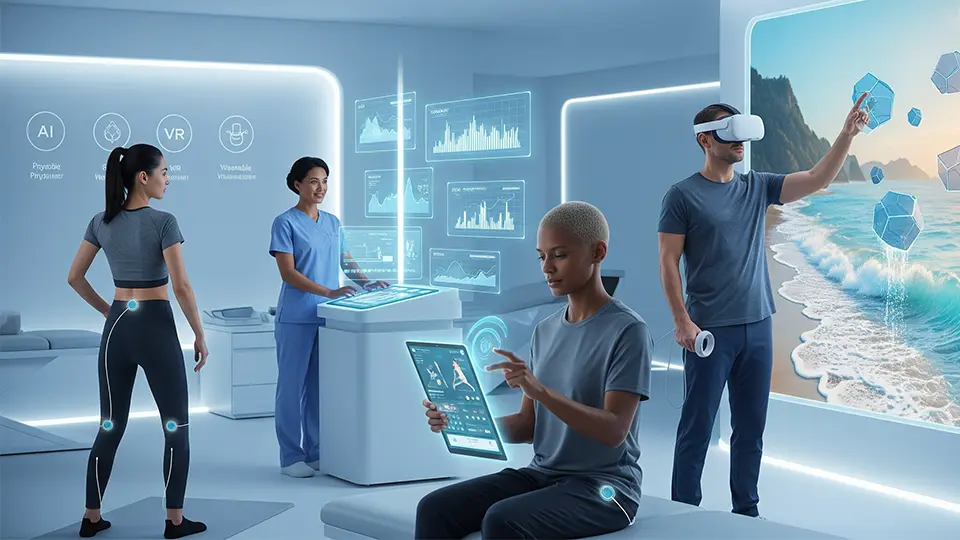

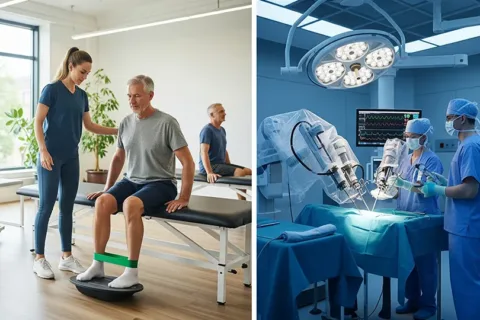

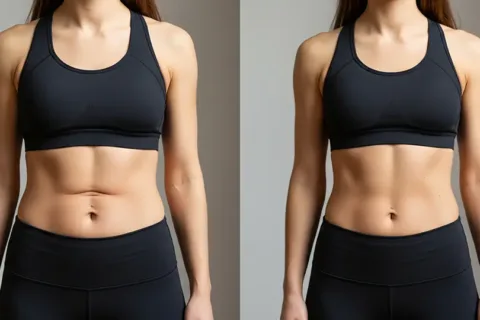


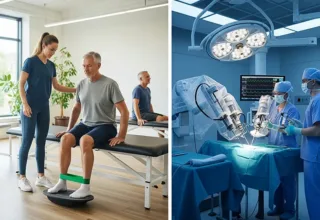

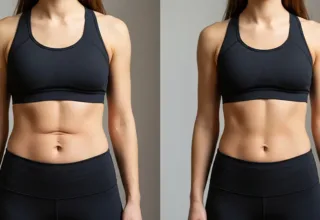
1 thought on “AI in Physiotherapy: How VR & Wearables Are Revolutionizing Rehab in 2025”
Thanks for all your efforts that you have put in this. very interesting info .